The Hardware Lottery
Introduction
Hardware, systems and algorithms research communities have historically had different incentive structures and fluctuating motivation to engage with each other explicitly. This historical treatment is odd given that hardware and software have frequently determined which research ideas succeed (and fail).
This essay introduces the term hardware lottery to describe when a research idea wins because it is suited to the available software and hardware and not because the idea is universally superior to alternative research directions. History tells us that hardware lotteries can obfuscate research progress by casting successful ideas as failures and can delay signaling that some research directions are far more promising than others.
These lessons are particularly salient as we move into a new era of
closer collaboration between hardware, software and machine learning
research communities. After decades of treating hardware, software and
algorithms as separate choices, the catalysts for closer collaboration
include changing hardware economics
Closer collaboration has centered on a wave of new generation hardware that is "domain specific" to optimize for commercial use cases of deep neural networks. While domain specialization creates important efficiency gains, it arguably makes it more even more costly to stray off of the beaten path of research ideas. While deep neural networks have clear commercial use cases, there are early warning signs that the path to true artificial intelligence may require an entirely different combination of algorithm, hardware and software.
This essay begins by acknowledging a crucial paradox: machine learning researchers mostly ignore hardware despite the role it plays in determining what ideas succeed. What has incentivized the development of software, hardware and algorithms in isolation? What follows is part position paper, part historical review that attempts to answer the question, "How does tooling choose which research ideas succeed and fail, and what does the future hold?"
Separate Tribes
It is not a bad description of man to describe him as a tool making animal.
For the creators of the first computers the program was the machine.
Early machines were single use and were not expected to be
re-purposed for a new task because of both the cost of the
electronics and a lack of cross-purpose software. Charles Babbage’s
difference machine was intended solely to compute polynomial
functions (1817)

The specialization of these early computers was out of necessity and
not because computer architects thought one-off customized hardware
was intrinsically better. However, it is worth pointing out that our
own intelligence is both algorithm and machine. We do not inhabit
multiple brains over the course of our lifetime. Instead, the notion
of human intelligence is intrinsically associated with the physical
1400g of brain tissue and the patterns of connectivity between an
estimated 85 billion neurons in your head
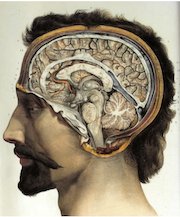
Today, in contrast to the necessary specialization in the very early days of computing, machine learning researchers tend to think of hardware, software and algorithm as three separate choices. This is largely due to a period in computer science history that radically changed the type of hardware that was made and incentivized hardware, software and machine learning research communities to evolve in isolation.
The general purpose computer era crystalized in 1969, when opinion
piece by a young engineer called Gordan Moore appeared in
Electronics magazine with the apt title “Cramming more components
onto circuit boards”
Moore’s law combined with Dennard scaling
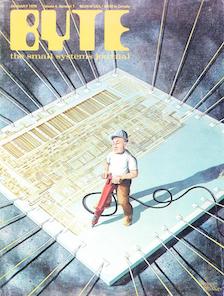
The emphasis shifted to universal processors which could solve a
myriad of different tasks. Why experiment on more specialized
hardware designs for an uncertain reward when Moore’s law allowed
chip makers to lock in predictable profit margins? The few attempts
to deviate and produce specialized supercomputers for research were
financially unsustainable and short lived
Treating the choice of hardware, software and algorithm as
independent has persisted until recently. It is expensive to explore
new types of hardware, both in terms of time and capital required.
Producing a next generation chip typically costs $30-80 million
dollars and takes 2-3 years to develop
In the absence of any lever with which to influence hardware development, machine learning researchers rationally began to treat the hardware as a sunk cost to work around rather than something fluid that could be shaped. However, just because we have abstracted away hardware doesn’t mean that it has disappeared. Early computer science history tells us there are many hardware lotteries where the choice of hardware and software has determined which ideas succeeded (and which failed).
The Hardware Lottery
I suppose it is tempting, if the only tool you have is a hammer, to treat everything as if it were a nail.
The first sentence of Anna Karenina by Tolstoy reads “Happy
families are all alike, every unhappy family is unhappy in it’s
own way.”
Despite our preference to believe algorithms succeed or fail in isolation, history tells us that most computer science breakthroughs follow the Anna Kerenina principle. Successful breakthroughs are often distinguished from failures by benefiting from multiple criteria aligning surreptitiously. For computer science research, this often depends upon winning what this essay terms the hardware lottery — avoiding possible points of failure in downstream hardware and software choices.

An early example of a hardware lottery is the analytical machine
(1837). Charles Babbage was a computer pioneer who designed a
machine that (at least in theory) could be programmed to solve any
type of computation. His analytical engine was never built in part
because he had difficulty fabricating parts with the correct
precision
As noted in the TV show Silicon Valley, often “being too early is the same as being wrong”. When Babbage passed away in 1871, there was no continuous path between his ideas and modern day computing. The concept of a stored program, modifiable code, memory and conditional branching were rediscovered a century later because the right tools existed to empirically show that the idea worked.
The Lost Decades
Perhaps the most salient example of the damage caused by not
winning the hardware lottery is the delayed recognition of deep
neural networks as a promising direction of research. Most of the
algorithmic components to make deep neural networks work had
already been in place for a few decades: backpropagation (1963
This gap between algorithmic advances and empirical success is in
large part due to incompatible hardware. During the general
purpose computing era, hardware like CPUs were heavily favored and
widely available. CPUs are very good at executing any set of
complex instructions but often incur high memory costs because of
the need to cache intermediate results and process one instruction
at a time.

The von Neumann bottleneck was terribly ill-suited to matrix
multiplies, a core component of deep neural network architectures.
Thus, training on CPUs quickly exhausted memory bandwidth and it
simply wasn’t possible to train deep neural networks with multiple
layers. The need for hardware that was massively parallel was
pointed out as far back as the early 1980s in a series of essays
titled “Parallel Models of Associative Memory.”
In the late 1980s/90s, the idea of specialized hardware for neural
networks had passed the novelty stage
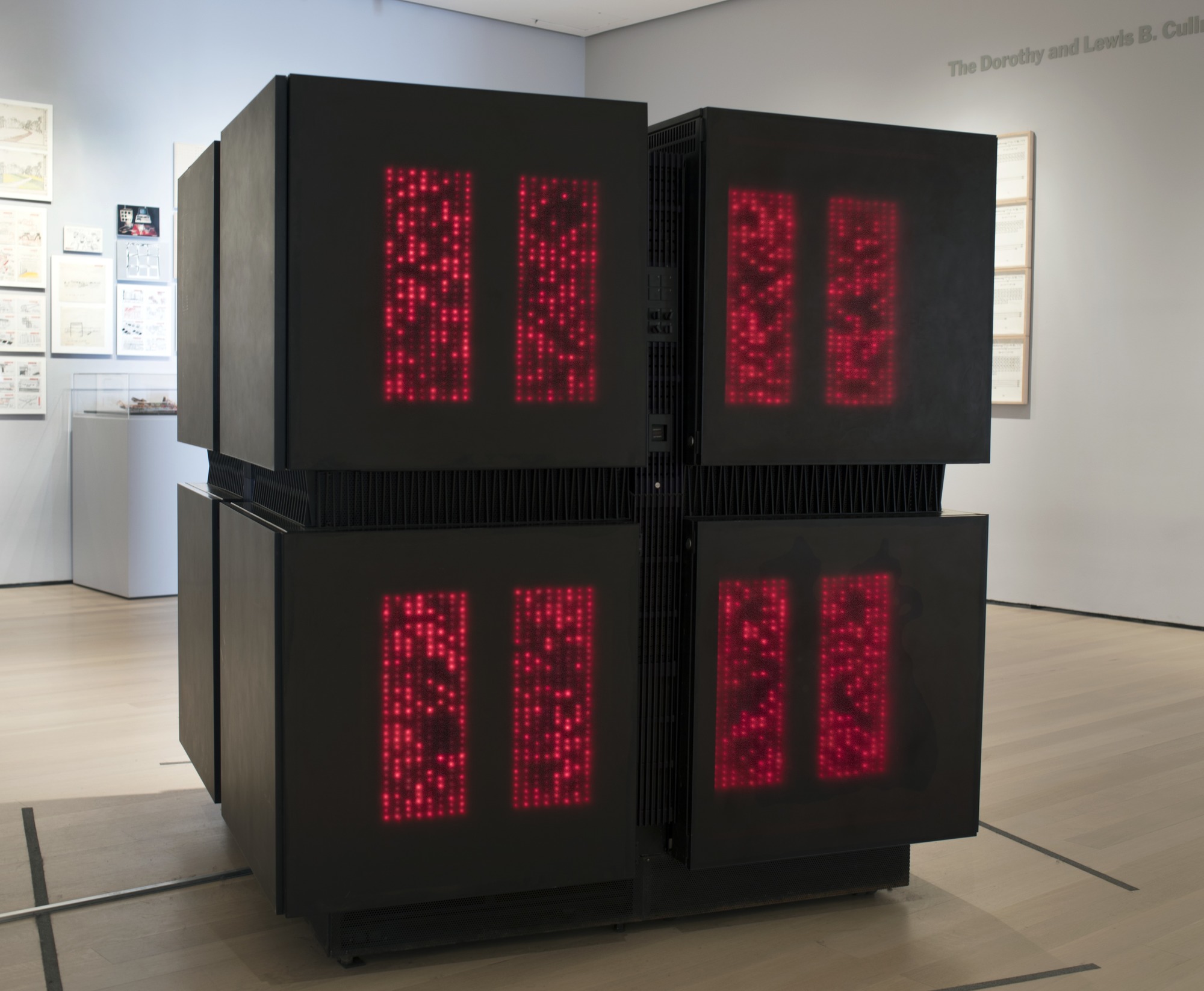
It would take a hardware fluke in the early 2000s, a full four
decades after the first paper about backpropagation was published,
for the insight about massive parallelism to be operationalized in
a useful way for connectionist deep neural networks. Many
inventions are re-purposed for means unintended by their
designers. Edison’s phonograph was never intended to play music.
He envisioned it as preserving the last words of dying people or
teaching spelling. In fact, he was disappointed by its use playing
popular music as he thought this was too “base” an application of
his invention
A graphical processing unit (GPU) was originally introduced in the
1970s as a specialized accelerator for video games and developing
graphics for movies and animation. In the 2000s, like Edison’s
phonograph, GPUs were re-purposed for an entirely unimagined use
case -- to train deep neural networks
This higher number of floating operation points per second (FLOPS)
combined with clever distribution of training between GPUs
unblocked the training of deeper networks. The number of layers in
a network turned out to be the key. Performance on ImageNet jumped
with ever deeper networks in 2011
Software Lotteries
Software also plays a role in deciding which research ideas win
and lose. Prolog and LISP were two languages heavily favored until
the mid-90’s in the AI community. For most of this period,
students of AI were expected to actively master one or both of
these languages

For researchers who wanted to work on connectionist ideas like
deep neural networks there was not a clearly suited language of
choice until the emergence of Matlab in 1992
Where there is a loser, there is also a winner. From the 1960s
through the mid 80s, most mainstream research was focused on
symbolic approaches to AI
The Persistence of the Hardware Lottery
Today, there is renewed interest in joint collaboration between
hardware, software and machine learning communities. We are
experiencing a second pendulum swing back to specialized hardware.
The catalysts include changing hardware economics prompted by the
end of Moore’s law and the breakdown of dennard scaling
The end of Moore’s law means we are not guaranteed more compute,
hardware will have to earn it. To improve efficiency, there is a
shift from task agnostic hardware like CPUs to domain specialized
hardware that tailor the design to make certain tasks more
efficient. The first examples of domain specialized hardware
released over the last few years -- TPUs
Closer collaboration between hardware and research communities
will undoubtedly continue to make the training and deployment of
deep neural networks more efficient. For example, unstructured
pruning
While these compression techniques are currently not supported,
many clever hardware architects are currently thinking about how
to solve for this. It is a reasonable prediction that the next few
generations of chips or specialized kernels will correct for
present hardware bias against these techniques
In many ways, hardware is catching up to the present state of
machine learning research. Hardware is only economically viable if
the lifetime of the use case lasts more than three years
There is still a separate question of whether hardware innovation is versatile enough to unlock or keep pace with entirely new machine learning research directions. It is difficult to answer this question because data points here are limited -- it is hard to model the counterfactual of would this idea succeed given different hardware. However, despite the inherent challenge of this task, there is already compelling evidence that domain specialized hardware makes it more costly for research ideas that stray outside of the mainstream to succeed.
In 2019, a paper was published called “Machine learning is stuck
in a rut.”
Whether or not you agree that capsule networks are the future of computer vision, the authors say something interesting about the difficulty of trying to train a new type of image classification architecture on domain specialized hardware. Hardware design has prioritized delivering on commercial use cases, while built-in flexibility to accommodate the next generation of research ideas remains a distant secondary consideration.
While specialization makes deep neural networks more efficient, it also makes it far more costly to stray from accepted building blocks. It prompts the question of how much researchers will implicitly overfit to ideas that operationalize well on available hardware rather than take a risk on ideas that are not currently feasible? What are the failures we still don’t have the hardware to see as a success?
The Likelyhood of Future Hardware Lotteries
What we have before us are some breathtaking opportunities disguised as insoluble problems.
It is an ongoing, open debate within the machine learning
community as to how much future algorithms will stray from models
like deep neural networks
Betting heavily on specialized hardware makes sense if you think that future breakthroughs depend upon pairing deep neural networks with ever increasing amounts of data and computation. Several major research labs are making this bet, engaging in a “bigger is better” race in the number of model parameters and collecting ever more expansive datasets. However, it is unclear whether this is sustainable. An algorithms scalability is often thought of as the performance gradient relative to the available resources. Given more resources, how does performance increase?
For many subfields, we are now in a regime where the rate of
return for additional parameters is decreasing
Perhaps more troubling is how far away we are from the type of
intelligence humans demonstrate. Human brains despite their
complexity remain extremely energy efficient. Our brain has over
85 billion neurons but runs on the energy equivalent of an
electric shaver
Biological examples of intelligence differ from deep neural
networks in enough ways to suggest it is a risky bet to say that
deep neural networks are the only way forward. While general
purpose algorithms like deep neural networks rely on global
updates in order to learn a useful representation, our brains do
not. Our own intelligence relies on decentralized local updates
which surface a global signal in ways that are still not well
understood
In addition, our brains are able to learn efficient
representations from far fewer labelled examples than deep neural
networks

Humans have highly optimized and specific pathways developed in
our biological hardware for different tasks
The point of these examples is not to convince you that deep neural networks are not the way forward. But, rather that there are clearly other models of intelligence which suggest it may not be the only way. It is possible that the next breakthrough will require a fundamentally different way of modelling the world with a different combination of hardware, software and algorithm. We may very well be in the midst of a present day hardware lottery.
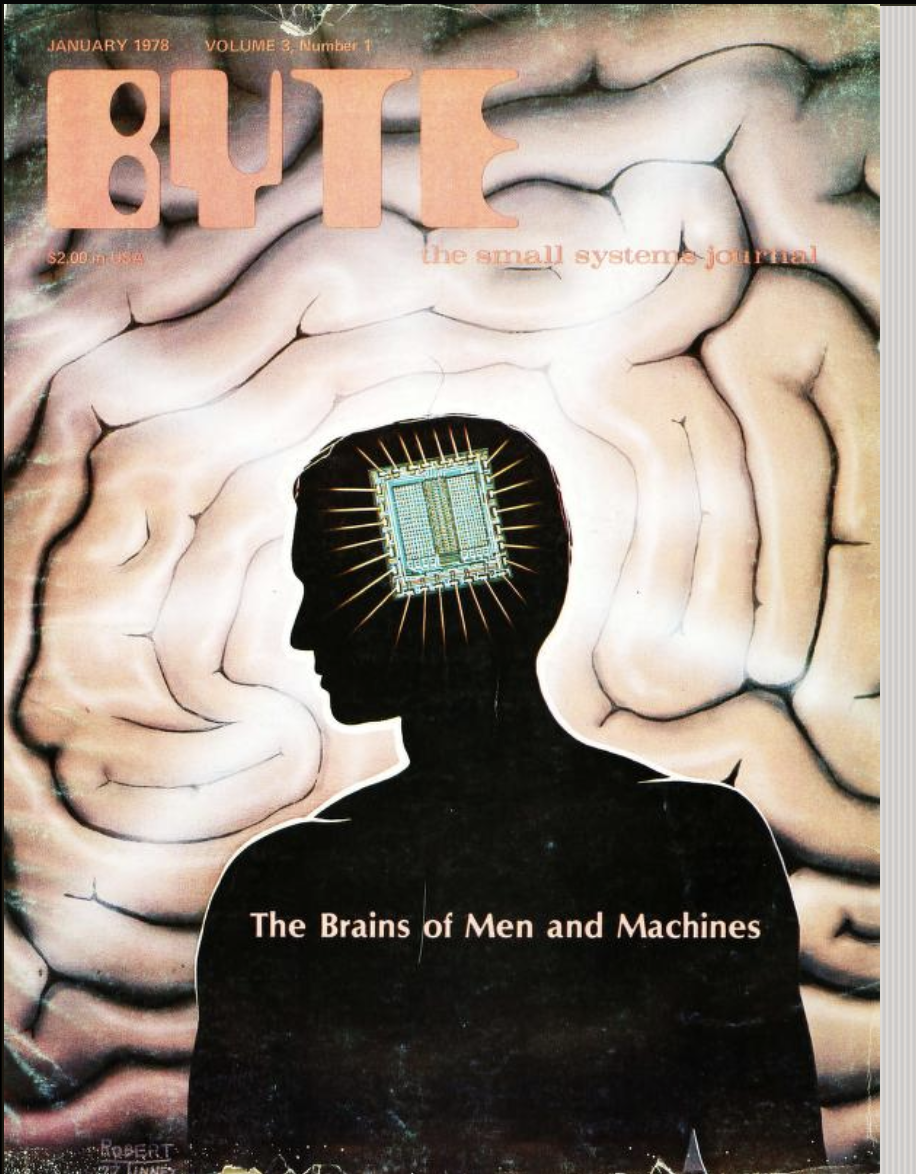
The Way Forward
Any machine coding system should be judged quite largely from the point of view of how easy it is for the operator to obtain results.
Scientific progress occurs when there is a confluence of factors which allows the scientist to overcome the "stickyness" of the existing paradigm. The speed at which paradigm shifts have happened in AI research have been disproportionately determined by the degree of alignment between hardware, software and algorithm. Thus, any attempt to avoid hardware lotteries must be concerned with making it cheaper and less time-consuming to explore different hardware-software-algorithm combinations.
This is easier said than done. Expanding the search space of
possible hardware-software-algorithm combinations is a
formidable goal. It is expensive to explore new types of
hardware, both in terms of time and capital required. Producing
a next generation chip typically costs $30-$80 million dollars
and 2-3 years to develop
Experiments using reinforcement learning to optimize chip
placement may help decrease cost
In the short to medium term hardware development is likely to
remain expensive and prolonged. The cost of producing hardware
is important because it determines the amount of risk and
experimentation hardware developers are willing to tolerate.
Investment in hardware tailored to deep neural networks is
assured because neural networks are a cornerstone of enough
commercial use cases. The widespread profitability of deep
learning has spurred a healthy ecosystem of hardware startups
that aim to further accelerate deep neural networks
The bottleneck will continue to be funding hardware for use
cases that are not immediately commercially viable. These more
risky directions include biological hardware
Lessons from previous hardware lotteries suggest that investment
must be sustained and come from both private and public funding
programs. There is a slow awakening of public interest in
providing such dedicated resources, such as the 2018 DARPA
Electronics Resurgence Initiative which has committed to $1.5
billion dollars in funding for microelectronic technology
research
The Software Revolution
An interim goal is to provide better feedback loops to
researchers about how our algorithms interact with the
hardware we do have. Machine learning researchers do not spend
much time talking about how hardware chooses which ideas
succeed and which fail. This is primarily because it is hard
to quantify the cost of being concerned. At present, there are
no easy and cheap to use interfaces to benchmark algorithm
performance against multiple types of hardware at once. There
are frustrating differences in the subset of software
operations supported on different types of hardware which
prevent the portability of algorithms across hardware types
These challenges are compounded by an ever more formidable and
heterogeneous hardware landscape
One way to mitigate this need for specialized software
expertise is focusing on the development of domain-specific
languages which are designed to focus on a narrow domain.
While you give up expressive power, domain-specific languages
permit greater portability across different types of hardware.
It allow developers to focus on the intent of the code without
worrying about implementation details
The difficulty of both these approaches is that if successful, this further abstracts humans from the details of the implementation. In parallel, we need better profiling tools to allow researchers to have a more informed opinion about how hardware and software should evolve. Ideally, software could even surface recommendations about what type of hardware to use given the configuration of an algorithm. Registering what differs from our expectations remains a key catalyst in driving new scientific discoveries.
Software needs to do more work, but it is also well positioned
to do so. We have neglected efficient software throughout the
era of Moore's law, trusting that predictable gains in compute
would compensate for inefficiencies in the software stack.
This means there are many low hanging fruit as we begin to
optimize for more efficient code
Parting Thoughts
George Gilder, an American investor, powerfully described the
computer chip as “inscribing worlds on grains of sand”
About the Author
Sara Hooker is researcher at Google Brain working on training models that fulfill multiple desired criteria -- high performance, interpretable, compact and robust. She is interested in the intersection between hardware, software and algorithms. Correspondance about this essay can be sent to shooker@google.com.
Acknowledgments
Thank you to my wonderful colleagues and peers who took the time to provide valuable feedback on earlier drafts of this essay. In particular, I would like to acknowledge the invaluable input of Utku Evci, Amanda Su, Chip Huyen, Eric Jang, Simon Kornblith, Melissa Fabros, Erich Elsen, Sean Mcpherson, Brian Spiering, Stephanie Sher, Pete Warden, Samy Bengio, Jacques Pienaar, Raziel Alvarez, Laura Florescu, Cliff Young, Dan Hurt, Kevin Swersky, Carles Gelada. Thanks for the institutional support and encouragement of Natacha Mainville, Hugo Larochelle, Aaron Courville and of course Alexander Popper.
Citation
@ARTICLE{2020shooker,
author = {{Hooker}, Sara},
title = "{The Hardware Lottery}",
year = 2020,
url = {https://arxiv.org/abs/1911.05248}
}
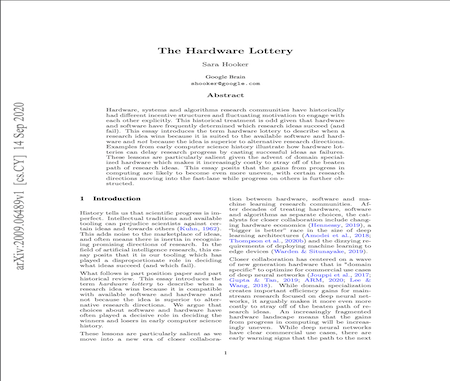
.jpg?v=1586843526885)